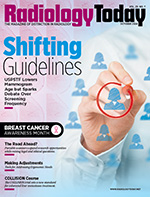 Editor’s Note: A Layered Approach
Editor’s Note: A Layered Approach
By David Yeager
Radiology Today
Vol. 25 No. 7 P. 4
October is Breast Cancer Awareness Month, and as we do each year, we are highlighting breast cancer news in our October issue. According to the American Cancer Society, the breast cancer death rate has been steadily declining since 1989, with an overall decline of 42% through 2021. However, breast cancer is still the second leading cause of cancer death among women, and there is a 1 in 40 chance that a woman will die from breast cancer. Despite progress that has been made in detection and treatment in recent years, there is still much work to be done.
Some big news this year was that the United States Preventive Services Task Force (USPSTF) lowered the age at which it recommends most women begin breast cancer screening mammography to 40. The previous recommendation was that they begin between the ages of 40 and 50. This is important because insurers must cover screenings that the task force recommends with an A or B grade. Although the recommendations can be viewed as a step in the right direction, many professional organizations and health care providers feel that they don’t go far enough. As Rebecca Montz reports in our cover feature, many experts and societies favor a more personalized, nuanced regimen, and they argue for a more far-reaching assessment of risk. The ACR, for example, recommends that all women undergo a comprehensive risk assessment at age 25. Time will tell whether the USPSTF eventually adopts a broader view of breast screening, but Montz offers an in-depth analysis of the issues that underlie screening and risk assessment.
Also in this issue, Beth W. Orenstein takes a look at the potential and potential challenges of portable MRI. The development of portable scanners promises to significantly expand clinical use cases for MR. Studies have found that portable MR units may be useful for stroke care, identifying clinical conditions faster so treatment can begin sooner. There is also research being done to determine whether including portable MR in ambulances is feasible.
In other news, Keith Loria has a rundown of the latest trends in ergonomics. As workloads increase, repetitive strain injuries become more likely. For tips on how to make your workspace more comfortable and efficient, turn to page 18.
Finally, Lauren Swisher reports on an exciting clinical trial that demonstrated significant results for improving the treatment of colorectal liver metastases. The researchers used thermal ablation to treat metastases that were 3 cm or smaller, and the trial met its goals early. In the future, fewer patients may require invasive surgery.
Enjoy the issue.— Dave Yeager
david.yeager@gvpub.com

